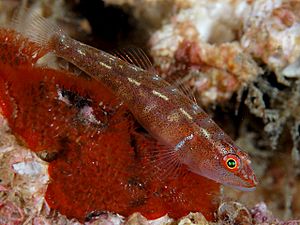Toothy goby facts for kids
Quick facts for kids Toothy goby |
|
|---|---|
 |
|
| Conservation status | |
| Scientific classification | |
| Genus: |
Pleurosicya
|
| Species: |
mossambica
|
The toothy goby, also known as the Mozambique ghost goby (scientific name: Pleurosicya mossambica), is a tiny fish that lives in the warm waters of the Indo-West Pacific Ocean. It's a type of goby fish. This small goby was first described in 1959 by a scientist named J.L.B. Smith. Like many other gobies, it often lives very closely with other sea creatures, like soft corals and sponges, in a special relationship called commensalism. This means one creature benefits, but the other isn't harmed.
Contents
What's in a Name?
The toothy goby has many common names! People also call it the common ghost goby, ghost goby, gudgeon, manyhost cling-goby, manyhost goby, and reef goby. Its scientific genus name, Pleurosicya, comes from two Greek words: pleura, meaning "side," and sikya, which means "cucumber." The species name, mossambica, tells us where it was first found: Mozambique.
Appearance and Features
The toothy goby is a very small fish. It only grows to about 3 centimeters (about 1.2 inches) long. It has a pale red color, and you can see through parts of its body. This fish has seven spines on its back fin and seven or eight soft rays. It also has one spine and eight soft rays on its anal fin.
Its eyes are quite big and have red and yellow rings around them. They are placed at an angle on its head, which helps the goby see a wider area around it. The goby's pelvic fins have changed over time into special suckers. These suckers help the fish stick to corals, even in places where the water current is strong.
What Do Toothy Gobies Eat?
Toothy gobies mainly eat tiny floating creatures called zooplankton. They also nibble on mucus and small parts of corals. Sometimes, when kept in aquariums, they have been seen cleaning tiny parasites off other fish. It's possible they do this for their host creatures in the wild too!
Life Cycle and Reproduction
The toothy goby is a special type of fish called a protogynous species. This means they are sequential hermaphrodites. They are born female and can mature as females first. Later in their lives, they can change into males. These gobies lay their eggs on the bottom of the ocean, often on sea squirts (called ascidians) or soft corals.
Where Toothy Gobies Live
The toothy goby lives across a large area of the Indo-West Pacific region. You can find them as far west as the Red Sea and the coast of eastern Africa. To the east, they reach Fiji and the Marquesas Islands. They live as far north as southern Japan and as far south as southeastern Australia and New Caledonia.
These gobies prefer to live in coastal bays and on reef slopes. They are usually found close to one of their many host creatures. They can live in water depths from about 2 to 30 meters (6.5 to 98 feet).
Living with Others: Ecology
The toothy goby lives among many different "hosts." These include soft corals, sponges, giant clams (like Tridacna), broad-blade plants, algae, and bivalves (like clams or oysters). There's even a story of one living with a blue sea cucumber off the coast of Bitung! They form a close relationship with these hosts.
Toothy Gobies and People
How Are They Doing? Conservation Status
The toothy goby is listed as a least-concern species by the IUCN (International Union for Conservation of Nature). This means there are no big known threats to this fish right now. People don't often catch them for trade. While they aren't specifically protected, they do live in areas that are protected. These include the Great Barrier Reef Marine Park in Australia and the Natural Park of the Coral Sea in New Caledonia.
Keeping Them in Aquariums
Sometimes, you might see a toothy goby in an aquarium. If kept in captivity, these tiny fish need at least 13 gallons of water. They will eat zooplankton and small crustaceans like krill, mysis shrimp, and artemia. Because they are so small, people who keep them need to be careful. They can easily get lost in aquarium overflow systems!
See also
 In Spanish: Pleurosicya mossambica para niños
In Spanish: Pleurosicya mossambica para niños


